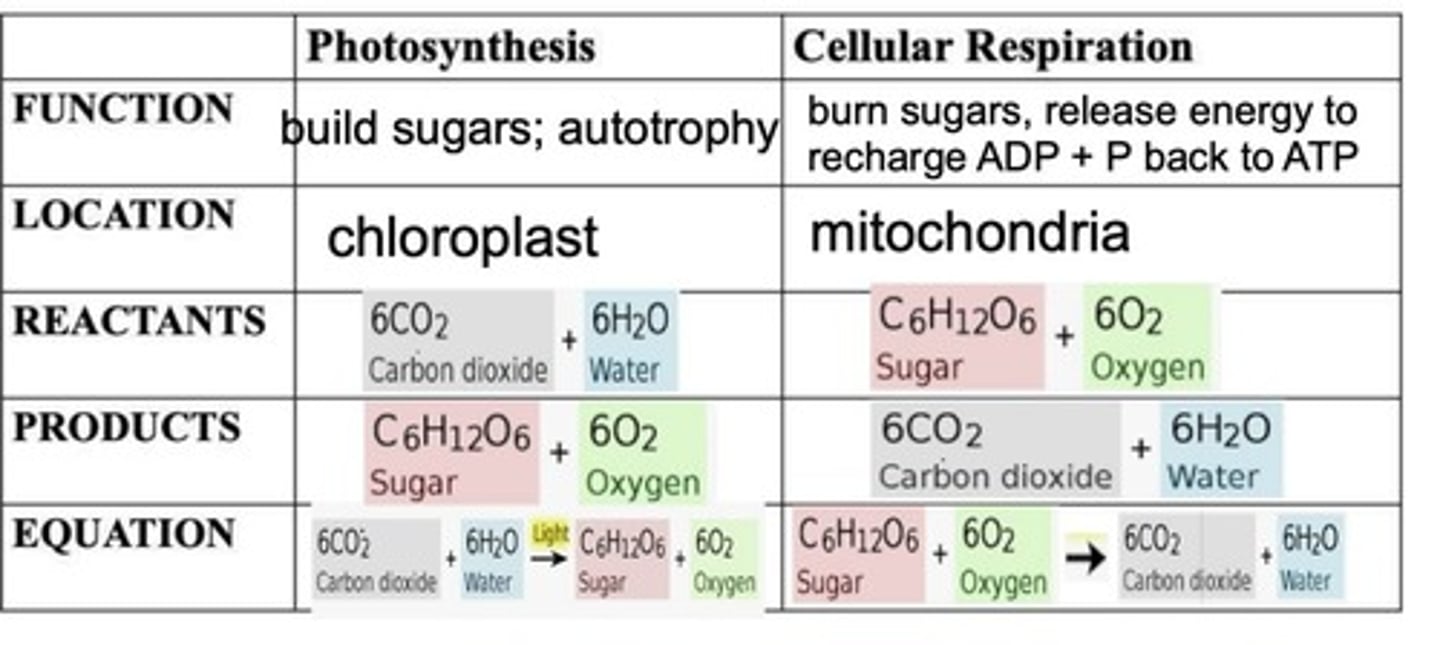Energy Flow and Photosynthesis in Ecosystems
1/36
There's no tags or description
Looks like no tags are added yet.
Name | Mastery | Learn | Test | Matching | Spaced |
|---|
No study sessions yet.
37 Terms
Autotrophs
Obtain energy by producing their own food through processes like photosynthesis or chemosynthesis.
Heterotrophs
Obtain energy by consuming other organisms or organic matter.
Mitochondria in plants
Plants possess both mitochondria and chloroplasts; mitochondria are involved in cellular respiration, using glucose to generate ATP for the plant's cellular processes.
Chloroplasts
Photosynthesis takes place in chloroplasts, which are organelles found within plant cells containing chlorophyll, essential for absorbing light energy.

Photosynthesis equation
6CO₂ + 6H₂O → C₆H₁₂O₆ + 6O₂; Reactants: Carbon dioxide (CO₂) and water (H₂O); Products: Glucose (C₆H₁₂O₆) and oxygen (O₂).
Light reactions location
Light reactions take place in the thylakoid membranes of the chloroplast.
Light reactions function
Transform light energy into chemical energy.
Calvin cycle location
The Calvin cycle takes place in the stroma of the chloroplast.
Calvin cycle function
Turn carbon dioxide from the air into sugar (glucose), the food autotrophs need to grow.
Environmental factors affecting photosynthesis
Light intensity, Carbon Dioxide Concentration, and Temperature.
Uses of sugars in plants
Plants break down sugars to create ATP, store excess sugars as starch, and use them to construct cell walls and other plant structures.
Matter movement in ecosystems
Matter is recycled while energy flows through; matter moves through organisms and the environment in biogeochemical cycles.
Energy movement in ecosystems
Energy flows in one direction.
Trophic levels
A level or position in a food chain, food web, or ecological pyramid occupied by a group of organisms with a similar feeding mode.
Energy loss in food webs
Energy gets lost at each step in a food web because organisms use most of it for their own life activities and release some as heat.
10% rule
Only about 10% of the energy from one trophic level is transferred to the next.
Energy pyramid
A graphical representation showing the energy available at each trophic level in an ecosystem.
Keystone Predator
Species that play a crucial role in maintaining the structure and health of an ecosystem.
Biological Magnification
The increasing concentration of a substance (like a toxin or pollutant) in the tissues of organisms as you move up a food chain.
Example of Biological Magnification
Biomagnification of DDT contributed to the near extinction of bald eagles and other birds. The birds absorbed DDT by eating contaminated fish and subsequently laid defective eggs.
Eutrophication
The process in which a water body becomes overly enriched with nutrients, leading to the plentiful growth of simple plant life.
Indicators of Eutrophication
The excessive growth (or bloom) of algae and plankton in a water body.
Stages of Cellular Respiration
1) Glycolysis, 2) The Krebs cycle (also called the citric acid cycle), 3) The electron transport chain (ETC).
Cytoplasm Stages of Cellular Respiration
Glycolysis.
Mitochondria Stages of Cellular Respiration
Krebs cycle and Oxidative Phosphorylation / Electron Transport Chain (occurs on the inner mitochondrial membrane).
Parts of a Mitochondria
Outer membrane: The skin of the mitochondrion. Inner membrane: A folded inner skin, with lots of wavy folds called cristae. Intermembrane space: The tiny space between the outer and inner skins. Matrix: The jelly-like goo in the very middle, inside the inner skin.
Mitochondria Function
The mitochondria is a 'recharging' station for ADP + P (uncharged) back to ATP (charged battery).
Energy Source for Mitochondria
Glucose and other food molecules (fats and proteins).
ATP Energy Usage
Releasing energy through the breakdown of its high-energy phosphate bonds, a process called hydrolysis.
Cellular Respiration Equation
The equation in both chemical symbols and in words, detailing reactants and products.
Aerobic
Refers to the process of generating energy with oxygen.
Anaerobic
Means producing energy without oxygen.
Fermentation Type
Anaerobic.
Lactic Acid Fermentation
Produces lactic acid.
Alcoholic Fermentation
Produces ethanol and carbon dioxide.
Photosynthesis and Cellular Respiration
Photosynthesis removes carbon dioxide from the atmosphere and converts it into organic molecules; Cellular respiration releases carbon dioxide back into the atmosphere as a byproduct of energy production.

Carbon Cycle Importance
Helps regulate Earth's temperature, provides the foundation for all life, and supports biodiversity.